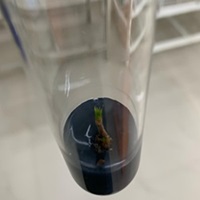1. Germplasm collection
A collection of 464 genotypes representing cocoa cultivation around the globe is maintained at the Cocoa Research Centre, Vellanikkara. Collections from the University of Reading, UK, and farmers’ fields across the nation have been collected since the year 1983. This germplasm collection consisting of 287 indigenous collections and exotic accessions forms a strong foundation for future crop improvement programmes. A collection of 81 Phytophthora-resistant genotypes, 192 superior plants in terms of yield and pod characters, and various vascular streak disease-resistant accessions were classified. The germplasm collection was utilized to develop 7 cocoa varieties (CCRP1-7).

Clones released from germplasm through selection
2. COCOA BREEDING PROGRAMMES
a. Breeding for yield
Hybridiziation between good combiner parents yields progeny with exceptional vigour, precocity and high yield. The major objective of the high yield breeding programme was to produce varieties with high yield, acceptable pod and bean traits and adaptibility to diverse situations. The result was the development of 7 varieties (CCRP 1-CCRP 7) and 8 hybrids (CCRP 8- 15) giving more pod yield than the pre-existing varieties.
a. Breeding for pest and disease-resistant varieties
Among the various pests and diseases that seriously affect cocoa cultivation in Kerala, vascular streak dieback (VSD) caused by Oncobasidium theobromae, Phytophthora, and tea mosquito bugs pose the major threat. Breeding programs for the development of resistant varieties are being conducted in this centre. Hybridization programme for the development of VSD resistance was initiated in the year 1998 using the hybrids produced in the centre. The pathogen being an inhabitant of xylem vessels is least affected by fungicide application. Hence, the use of resistant varieties is considered to be the best strategy.
Phytophthora rot resistance in cocoa is yet another relevant aspect under aggressive research, as it poses a serious threat during monsoon season. Various cultural, biological, and chemical management practices are followed for disease management. However, the use of resistant hybrids offers better prospects. The centre released resistant varieties and currently double crosses are being studied for coupling disease resistance and high yield.
Tea mosquito bug has been considered a relevant emerging pest of cocoa. As the insect belongs to the same order as the pollinator ceratopogonid midges, insecticide application is not advisable. An attempt to develop tea mosquito bug-resistant cocoa genotypes was initiated using 20 cocoa hybrids. Resistant hybrids were identified and are being evaluated. A molecular study using SSR markers is also being conducted.

VSD I 31.8 Released hybrid breed for VSD resistance
b. Breeding for drought tolerance
Drought is considered as one of the major factors affecting cocoa cultivation. Water stress affects the most important determinants of yield-canopy architecture, photosynthesis and partitioning of assimilates. Hence, efforts were made to increase the water use efficiency. The recent reports say that there is a day-to-day decrease in the potential water sources for day-to-day basic activities and in such a condition, it is necessary to evolve genotypes that are tolerant to the drought stress.
Cocoa Research Centre, Kerala Agricultural University is on the move to evolve drought-tolerant genotypes. Studies helped to identify some drought-tolerant genotypes that have been utilized as the parent population to develop hybrids that were tolerant to drought. The germplasms at the Centre were also analyzed for drought stress which led to the identification of nine highly tolerant and ten tolerant genotypes leading to the development of genetic stock for drought stress.

c. Breeding for increased production and quality
The institute developed twenty-one hybrids with high yield and containing large beans (>2.5 g) and has also developed three-way cross hybrids that had high-fat content. The centre was also successful in developing nine hybrids that had high polyphenol content (>7%) through a three-way crossing program. Thus, the institute has succeeded in developing hybrids that had increased quality and also produced more pods than the normal range.
Inbreeding programmes
The inbreeding program involves the production of completely homozygous, high-yielding plants that can be further used for further hybridization. The program was initiated in the year 1987 using high-yielding self-compatible plants. Inbreeding has been difficult in cocoa due to its complex genetic architecture and its self-incompatibility nature. However, the Cocoa Research Centre is the first institute in the world that has developed the 6th generation of inbred cocoa.

Tissue culture
Clonal propagation of superior genotypes through in-vitro methods was one of the identified thrust areas of cocoa biotechnology. Under this background, our objective is to develop a protocol, for in-vitro regeneration among elite cocoa clones. We have succeeded in developing a protocol for the initiation and multiplication of CCRP 1-15 clones and hybrids, and now the main focus is on rooting and primary hardening.


VARIETIES RELEASED
1. CCRP 1 (M 16.9)
2. CCRP 2 (M 13.12)
3. CCRP 3 (G I 5.9)
4. CCRP 4 (G II 19.5)
5. CCRP 5 (G IV 18.5)
6. CCRP 6 (G VI 55)
7. CCRP 7 (G VI 56)

KAU RELEASED COCOA HYBRID VARIETIES (CCRP 8 – CCRP 15)
1. CCRP 8
2. CCRP 9
3. CCRP 10
4. CCRP 11
5. CCRP 12
6. CCRP 13
7. CCRP 14
8. CCRP 15





